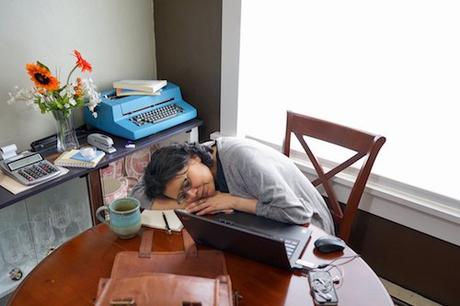
Please read this important and informative guest post on sleep apnea in women by Alex Deckard. Better still, have your spouse or mate read it if you suffer from the symptoms and determine if testing might be for you.
Sleep Apnea in Menopausal Women by Alex Dickard
The symptoms of menopause are well known: weight gain, hot flashes, insomnia, night sweats, mood swings, fatigue, migraines. Some people assume slowing down is part of the natural aging process and accept it. Even though our bodies do change as we age, you should be aware that some symptoms related to menopause could be an indication of something more serious.
Symptoms such as irritability, fatigue, and migraines might be from a more dangerous culprit: sleep apnea. Sleep apnea is a serious sleep disorder that occurs when a person’s sleep is interrupted. There are three types of sleep apnea: obstructive, central, and complex.
Obstructive sleep apnea happens when the upper airway partially or completely collapses during sleep. To catch your breath, your brain sends a signal to slightly wake you up. Central sleep apnea happens when your brain doesn’t send the signal to breathe. Complex sleep apnea is a combination of both.
Everybody knows how languid you feel following a poor night’s rest. Now imagine experiencing that every day!
25 million Americans suffer from obstructive sleep apnea, but sleep apnea is typically seen as a man’s disease. A 2013 medical study from UCLA found that women are less likely than men to be diagnosed with sleep apnea. In fact, women are more likely to have sleep apnea misdiagnosed with depression, hypertension, and hypochondria. Because women aren’t in as many clinicial trials, doctors don’t recognize sleep apnea symptoms.
Fortunately, a recent study found hot flashes and night sweats may be linked to an increased risk of obstructive sleep apnea in middle-aged woman.
Sleep Apnea in Women
The answer as to why men do not have this problem can be found in the male sex hormone testosterone. Testosterone is known to decrease insulin and increase muscle mass. It also has an anti-inflammatory effect helping to manage stress hormones for men.
While women have some testosterone, they are much more dominant in estrogen and progesterone. These hormones are not known to have a stress managing effect on a woman’s body. Estrogen also has an anti-inflammatory effect — as women move into menopause, estrogen levels tend to drop, making falling asleep a lot more challenging.
It turns out female hormones are likely to play a role in women of that certain age group experiencing symptoms of sleep apnea.
Estrogen and serotonin (one hormone that transmits nerve signals) are directly related. When estrogen is higher in the body, so too is serotonin. When serotonin is lower, due to a drop in estrogen from menopause, the signal from your brain to muscles, including your tongue. When the tongue relaxes, the airway is blocked causing breathing problems. Here lies the complicated relationship between menopause and sleep apnea.
Sleep Apnea Testing
For a middle-aged woman, it can be difficult to determine if your symptoms are due to sleep apnea or a hormonal imbalance. Most people seek out sleep apnea testing because a loved one notices the stoppages in breathing.
A sleep test is the most effective way to diagnose a sleep apnea. Most people pack their overnight bag and head to the sleep lab. A polysomnogram will detect a wide range of sleep disorders. A sleep test in a laboratory can be expensive (up to $3000), and many people have difficulty sleeping outside of their bed with so many sensors.
Fortunately, a study confirmed that at-home sleep tests are just as effective in diagnosing obstructive sleep apnea. In-home sleep tests costs a fraction of a lab test (around $250), and you can sleep in the comfort of your own bed.
A home sleep test uses a finger probe to measure the blood oxygen level and pulse rate. The device can also measure the patient’s Apnea Hypopnea Index (AHI), which is the number of times in one hour an individual experiences a pause in breathing for ten seconds or more. AHI is the primary unit of measurement to determine the severity of sleep apnea.
Sleep Apnea Treatment
While a cure for obstructive sleep apnea might not be possible, there are different types of sleep apnea treatment. Some lifestyle changes can help such as eating better, abstaining from smoking and alcohol, and losing weight.
There are surgical options that shrink or remove excess soft tissue. Speciality mouth guards move the lower jaw forward to increase the size of the upper airway.
The most common and effective treatment for sleep apnea is CPAP therapy. CPAP or “Continuous Positive Airway Pressure” delivers pressurized air to keep your airway open. Because it reduces the number of apnea episodes, CPAP machines allow you to experience REM sleep.
Undiagnosed sleep apnea creates or exacerbates a host of other health conditions such as: headaches, diabetes, depression, anxiety, heart disease, weakened immune system, and more. Sleep apnea treatment can improve your long term health and your day to day life.

